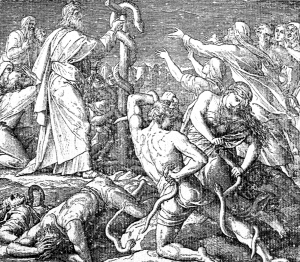 The Children of Israel wandered forty years in the desert. Several times they again forgot God and murmured against Moses and Aaron.
The Children of Israel wandered forty years in the desert. Several times they again forgot God and murmured against Moses and Aaron. The Children of Israel wandered forty years in the desert. Several times they again forgot God and murmured against Moses and Aaron.
The Children of Israel wandered forty years in the desert. Several times they again forgot God and murmured against Moses and Aaron.
Once, when they could not find fruit or water, they were angry and said to Moses. "Why have you brought us into this desert to die? Here no fruit, or grain, or vine, will grow. We cannot even find water to drink."
Moses and Aaron went to the Tabernacle to pray for the people. God told Moses to strike a rock before the Israelites. God promised that the rock would give forth water for them to drink.
Moses called the people together in front of the rock. He struck the rock two times. From the rock water gushed forth, and the people could drink.
Now Moses struck the rock two times because he knew how wicked the Israelites had been. He wondered if God would really give them water, as He had promised, even when they had been very wicked.
God saw this lack of faith, and said to Moses, "Because you have not believed Me you shall not lead the people into the Promised Land."
The Children of Israel were very ungrateful to God in the desert, in spite of so many benefits they received from Him. They even murmured against God. They blamed Moses for all their troubles, saying, "Why did you bring us out of Egypt to die in the wilderness? Here we have no water. We are tired of eating manna, and there is no other bread."
To punish the wicked people, God sent serpents to bite them. Many of them died. The people went to Moses and begged him to pray God that the serpents be taken away. God said to Moses, "Make a serpent of brass. Everyone who looks on that shall live."
Moses fashioned a serpent of brass and set it up for a sign. Whenever someone was bitten by a serpent, he would look at the brass serpent and get cured.
This serpent of brass was a figure of Christ, Who was nailed on the Cross on Mount Calvary to save mankind.
- from My Bible History in Pictures, by Bishop Louis LaRavoire Morrow, D.D., 1934; it has the Imprimatur of Archbishop Michael J O'Doherty of Manila, Philippines